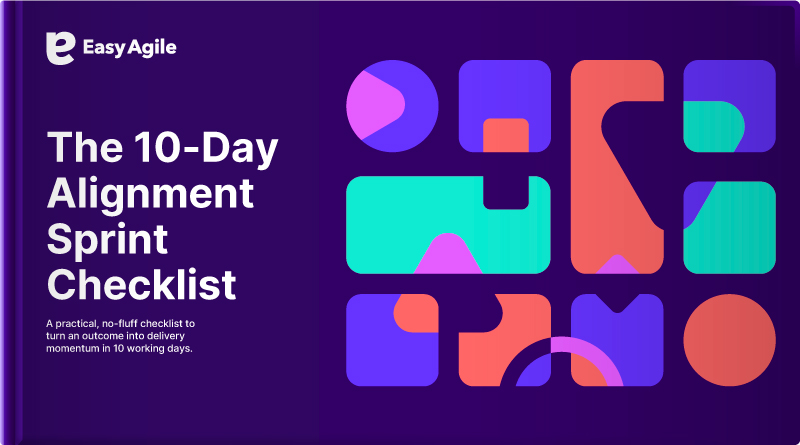Free 10‑Day Program Planning Checklist
Want to set clear goals for your team, connect their daily work to objectives, remove dependencies, and stay on track with focused reviews - all in 10 working days? This free checklist shows you exactly how.

Template highlights
- Day-by-day plan (10 working days)
A short cadence that takes you from one clear outcome and 1–3 KPIs to visible progress in two weeks. Every day has a small task and a concrete output, so teams keep moving instead of re-planning. - Objective setup you can defend
Pick 3–5 objectives that tie directly to the outcome. Each has one owner, a target date, and Business Value (BV 1–10). BV makes priority calls quick and explainable - use it to break ties and stop re-litigating decisions. - Work mapping that sticks
Connect the right epics/stories to each objective so effort matches intent. You’ll see what’s missing (orphans), spot over-commitment early, and keep estimates light (S/M/L) so planning doesn’t stall. - Dependencies grid (real risk, named)
A simple list that shows what is blocking what, with one owner → next step → due date → blocked item. It keeps risks in the open and makes sequence changes straightforward instead of political. - Worked example you can copy
A realistic, end-to-end example runs through the template. It shows the level of detail, how BV is used to choose, and how updates look when they are useful to leaders.
Works with any tools you use. Pairs neatly with Easy Agile Programs in Jira.
Benefits of a 10-day program planning template
- Goals people follow: one outcome and a few KPIs everyone remembers and acts on.
- Fewer, clearer priorities: you commit to 3–5 objectives, so effort stops spreading thin.
- Faster, fair decisions: Business Value ends long debates and explains why A beats B.
- Work tied to results: teams link tasks to objectives, cut the rest, and show real progress.
- Risks surfaced early: blockers have an owner and a date, so issues don’t sit silent for weeks.
How to use the template
- Set the outcome (Day 1). Write one clear sentence and 1–3 KPIs that prove progress.
- Choose 3–5 objectives (Day 2). Give each an owner, target date, and Business Value.
- Map work to goals (Day 3). Link the right epics/stories to each objective; add simple S/M/L estimates.
- Make risks visible (Day 4). Start a dependency list with owner → next step → due date → blocked item.
- Keep momentum (Days 5 & 8). Run two short reviews: status → risk → next action; share one-screen updates.
- Decide by value (Day 9). Use BV scores to resolve clashes quickly; record the decision.
- Show impact & reset (Day 10). Share a short result per objective and book the next two-week plan.
Like the flow? The download gives you the ready-to-use tables and examples so this becomes routine - not a one-off.
Who gets value from this
- Program/Delivery leads coordinating multiple teams.
- Product & Engineering leaders who want a steady two-week rhythm from plan to visible progress.
- Agile coaches who need a simple way to standardise goals, value, and dependencies across teams.
Works smoothly with Easy Agile Programs and Jira
Use the template on its own, or mirror the same habits in Jira with Easy Agile Programs for a live view. No extra ceremonies required.
- Objectives board: create goals, set BV, assign owner and date.
- Link work: attach epics/stories to each goal to show coverage.
- Program Board: see timing and dependency lines; adjust sequence safely.
- Objectives report: share a clean snapshot by team and objective.
Get instant access to the full template
Join the 10,000 product teams already using Easy Agile




































Program Planning FAQs
Frequently asked questions
Everything you need to know about the program planning and alignment sprints
Yes - framework-agnostic. The 10-Day Alignment Sprint Checklist fits OKR-style outcomes/KPIs and complements PI planning by keeping alignment alive between big-room sessions (and by using BV 1–10 and committed/uncommitted objectives, which are common in PI contexts).
Keep a compact dependencies grid: owner → next step → due date → blocked item, and make it part of the weekly rhythm. The 10-Day Alignment Sprint checklist uses Red/Yellow/Black status and ties each risk to the exact item it blocks so sequence changes are straightforward. This reflects widely recommended cross-team dependency practices.
Business Value (BV 1–10) is a simple scoring method used in PI/program planning to rank objectives by impact; higher BV wins when resources clash. The 10-Day Alignment Sprint Checklist applies BV to make trade-offs quick and defensible, and to record a one-line rationale so decisions don’t keep reopening.
Most teams keep it tight at 3–5 objectives for focus in short cycles. (In PI contexts, guidance often ranges higher, but still stresses clarity, SMART wording, and using committed vs uncommitted objectives.) The 10-Day Alignment Sprint Checklist standardises 3–5 with owners and dates so effort doesn’t spread thin.
Aim for one minute per objective: status → risk → next action - then share a one-screen snapshot. The 10-Day Alignment Sprint checklist schedules two such reviews in ten days to keep decisions moving between bigger PI/quarterly events.
Use the 10-day Alignment Sprint checklist: set one outcome with 1–3 KPIs, choose 3–5 objectives, score them with Business Value (BV 1–10), link work to goals, surface cross-team dependencies, and run two short reviews to keep momentum. This mirrors common program/PI planning practices without heavy ceremony.
Map each epic/feature (and stories) to one objective so coverage is visible and “orphan” work is cut. The 10-Day Alignment Sprint checklist calls this “work mapped to goals,” and keeps estimates light (S/M/L) to avoid planning stalls - practical, tool-agnostic hygiene many program teams follow.